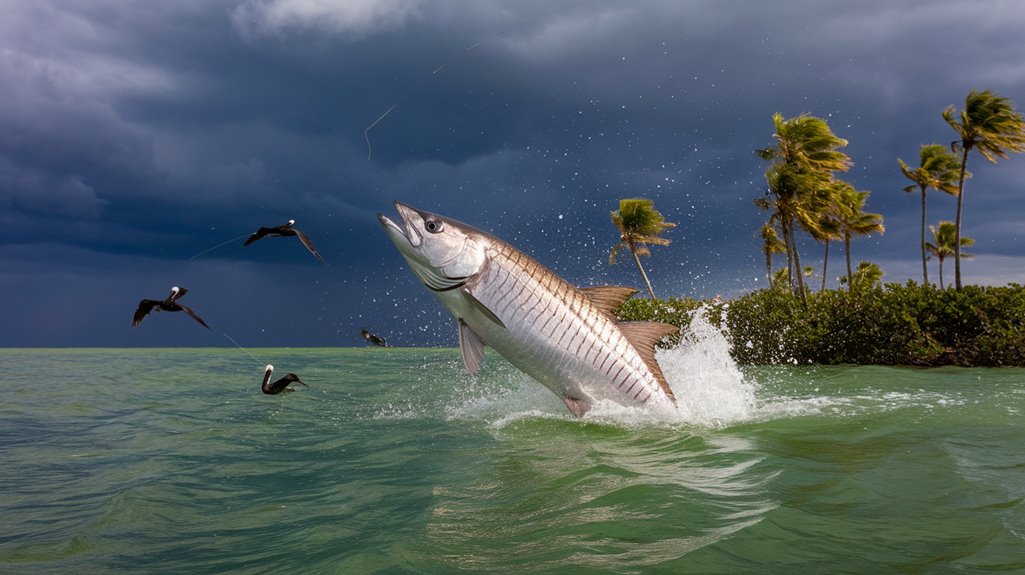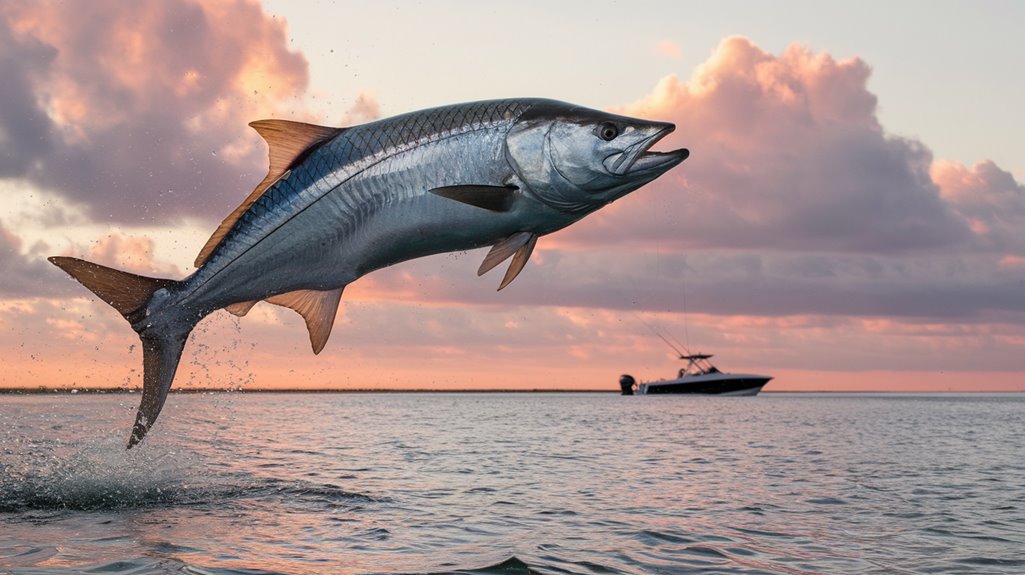On a sweltering July morning at Ocracoke Inlet, you'll find tarpon rolling across the surface as they follow mullet schools through the pass. These prehistoric gamefish, Megalops atlanticus, strategically time their North Carolina arrival with specific water temperatures and baitfish patterns. While most anglers focus on Florida's tarpon fishery, North Carolina's seasonal migration offers a unique opportunity to target these silver kings in less pressured waters.
Key Takeaways
- Tarpon begin migrating to North Carolina waters when temperatures reach 79°F, with first arrivals reaching Pamlico Sound by late June.
- Prime fishing locations include Pamlico River, Pungo River, and Ocracoke Inlet, especially where saltwater meets freshwater.
- The peak tarpon fishing season runs from mid-July through Labor Day, offering the best chances for success.
- Tarpon congregate at Ocracoke Inlet before splitting into smaller groups, following water temperature changes and prey availability.
- Blue crabs and baitfish activity in mixing zones where fresh and saltwater meet create optimal fishing conditions.
Understanding North Carolina's Tarpon Migration Patterns
As water temperatures climb to approximately 79 degrees Fahrenheit, tarpon begin their annual migration into North Carolina's coastal waters, with the first arrivals typically reaching Pamlico Sound by late June.
You'll find these migratory tarpon first congregating at Ocracoke Inlet before they disperse into smaller groups throughout the region's waters. Their movement patterns are highly predictable, driven by water temperature fluctuations and the presence of prey species, particularly blue crabs in the mixing zones between salt and fresh water.
The peak season for tarpon fishing in North Carolina extends from mid-July through Labor Day, when the largest specimens are most active. Acoustic tagging research has confirmed that these fish are part of a broader East Coast migration, making North Carolina's waters a vital stop in their annual cycle.
Prime Locations for Tarpon Fishing Success
Three key regions stand out as premier tarpon fishing locations in North Carolina: the Pamlico River, Pungo River, and Ocracoke Inlet. These prime locations offer ideal conditions where saltwater meets freshwater, creating rich feeding grounds abundant with blue crabs that attract large schools of tarpon during their migration.
You'll find the best time of year for tarpon fishing is from mid-July through Labor Day, with peak activity in late summer and early fall. The waters around Ocracoke Inlet become particularly productive in late June when migrating schools begin dispersing into the surrounding areas.
Easy access to these fishing grounds is available through public boat ramps in Carteret, Hyde, and Pamlico counties. For consistent success, focus on historical feeding areas that have proven reliable for tarpon catches year after year.
Essential Gear and Bait Selection
Successful tarpon fishing hinges on selecting the right combination of equipment and bait to match these powerful gamefish. During early North Carolina fishing trips, you'll need medium-heavy tackle with 20- to 30-pound test line and high-capacity reels to handle these highly migratory fish. Your leader should be 6 to 8 feet of 60-pound test or stronger line to withstand powerful runs.
For ideal bait selection, consider these essentials:
- Fresh bait options including croaker, spot, and mullet
- 6/0 to 8/0 super-sharp J-hooks or octopus circle hooks
- Both weighted and unweighted presentations
Replace your fresh bait every 10 to 15 minutes for maximum effectiveness when targeting tarpon. This systematic approach to bait management increases your chances of success when these predators travel in small pods through North Carolina waters.
Seasonal Strategies and Techniques
Targeting tarpon in North Carolina requires precise timing aligned with their migration patterns, which begin when water temperatures reach 79 degrees in late June. As these fish migrate northward from late spring, they follow established travel routes through river systems where freshwater meets saltwater, creating incredible fishing opportunities.
You'll find good numbers of tarpon in areas with abundant blue crab populations during peak season, which runs from mid-July through Labor Day. To maximize your success, anchor in productive locations and employ a dual-bait strategy using both weighted and unweighted presentations. Rotate fresh baits like croaker, spot, and mullet every 10-15 minutes to maintain ideal attraction. This systematic approach, combined with targeting mixing zones where fresh and saltwater converge, will greatly increase your chances of multiple hookups.
Weather Conditions and Water Temperature Impact

Understanding weather patterns and water temperature fluctuations proves critical for tarpon anglers in North Carolina's coastal waters. When water temperatures reach 79 degrees in late June, you'll notice migrating tarpon entering local waters. Weather conditions directly influence your fishing success, with light winds providing ideal fishing conditions for sight fishing opportunities.
Key factors affecting your tarpon fishing experience:
- Water temperature triggers migration patterns and feeding behavior
- Wind conditions impact your ability to spot and present bait effectively
- Baitfish activity peaks during falling tides in calm weather
Monitor the presence of Spanish mackerel and menhaden, as these baitfish attract tarpon to specific areas. You'll find the most productive fishing during periods of stable weather, when calm seas and warm waters align with seasonal baitfish movements.
Frequently Asked Questions
What Month Is Best for Tarpon Fishing?
You'll find the best tarpon fishing during July and August when water temperatures reach ideal levels and trophy-sized specimens are most abundant and actively feeding in coastal waters.
Where to Catch Tarpon in North Carolina?
Like silver shadows in brackish waters, you'll find tarpon in Pamlico and Pungo rivers, particularly where saltwater meets fresh. Focus on Ocracoke Inlet's nearshore reefs and crab-rich feeding grounds.
What Is the Tarpon Migration Route?
You'll find tarpon entering through Ocracoke Inlet before dispersing into Pamlico Sound, following underwater channels to the Pamlico and Pungo rivers where they track blue crab populations in saltwater-freshwater mixing zones.
How Old Is a 100 Pound Tarpon?
You'll find that a mighty 100-pound tarpon is typically 10-15 years old, though growth rates can vary based on environmental conditions, food availability, and habitat quality in their ecosystem.
Conclusion
You'll find that timing is everything when pursuing Megalops atlanticus in North Carolina waters. The scientific data confirms that ideal conditions occur when water temperatures stabilize at 79°F, typically from mid-July through early September. As the old saying goes, "fish where the fish are," so focus your efforts at the estuarine convergence zones of Pamlico and Pungo Rivers, where these prehistoric predators naturally congregate during their seasonal migration pattern.

